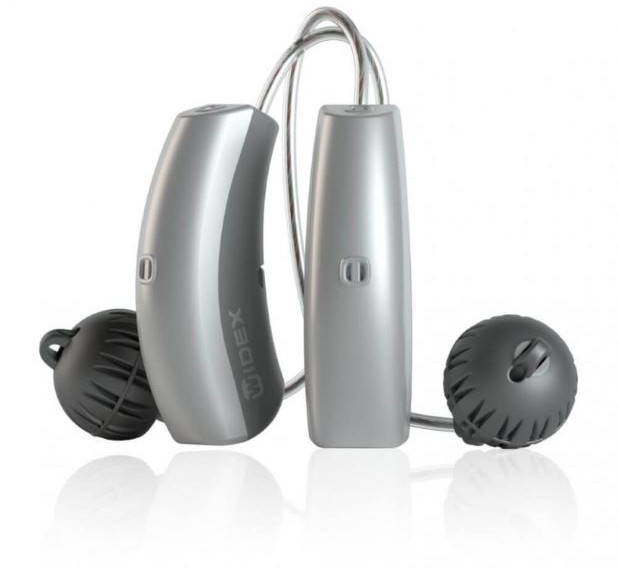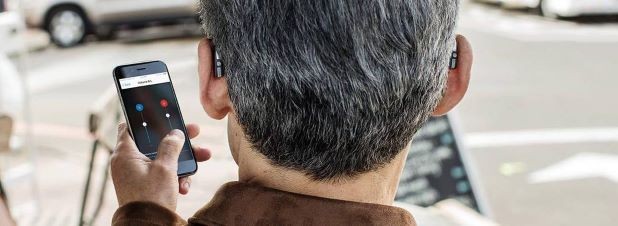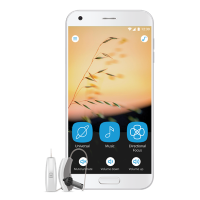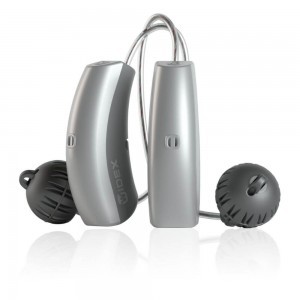
Widex Evoke Hearing Aids
Reviews, Styles, Features & Benefits
SUPERSEDED HEARING AID
2020 Update: This model has now been superseded by the Widex Moment range.
The Widex Evoke range is the latest from Widex including Machine Learning, in the Fusion2 model. This model, like the rest from this manufacturer, combines style, functionality and technology together - the typical characteristics of the Widex design.
Widex claims that this particular range is their ‘era of intelligent hearing’ and boasts that the quality and clarity of your hearing experience will organically evolve – in real time. To put it simply, Evoke analyses data as you wear your hearing aids, and constantly learns as you go. The overall result is that you will hear as perfectly as possible.
The idea is that you can take the reins and control your hearing aids. Or choose to relax and let Evoke take over, for a more carefree lifestyle and bespoke listening experience - an ideal option for an active lifestyle, within a fast-paced world.

Widex Evoke Hearing Aids
What makes them so intelligent?
SoundSense technology
Using the SoundSense technology your hearing aids will develop a deeper understanding of your lifestyle, as you personalise your hearing situations. We are impressed with the smartness of Evoke and the fact that it learns every day. So, today’s experience will be even better tomorrow.
We personally like the way you can control your hearing needs with a touch of your fingertips and that all this data is so easily accessible and discreet. Evoke knows the difference between jazz and rock music. It knows the difference between how a conference sounds and how a dinner party sounds. In addition, it will adjust to you on the go, as it deciphers your location and environment, using the Fluid Sound Analyser.
You can also take control and teach Evoke how you want to hear sound with two sound profiles, in the Sound Sense Learn feature. So, you can listen to music your way, as many times as you wish.
Another handy tool, that’s great for those noisy social gatherings, is the Fluid Sound Controller. You can filter unwanted sound, that might disturb your hearing conversations, so you hear what you want to hear. But, in a quiet one-to-one coffee catch up – you might choose to hear all the details that surround you.

Widex Evoke hearing aids never forget
This Evoke is so smart it never forgets. However, because these hearing aids are so smart – you might forget you are wearing them! Which, comfort-wise, is always a good thing.
This is due to the SoundSense Adapt technology, it never forgets the changes you have made in the past. So, when you are having a coffee with a friend in a new spot, it adapts your sound experience using settings from similar situations.
Widex Evoke Hearing Aids
Great personalised listening experiences at your fingertips
What if I don't want to take charge of my listening experience?
Well, in all honesty, this hearing aid is not for you. Evoke is for those who have an active and social lifestyle - who want to control their hearing situations at a drop of a hat. But, for instance, if you wanted the 'day off', so to speak, you can use the Universal program, which automatically adjusts your hearing wants and needs by judging your environment.
Together with the Fluid Sound Analyser and Controller - you have the best auto pilot there is!
Styles available in the Widex Evoke hearing aid range:
- RIC 10, RIC 312 D, Passion, Fusion, Fusion 2
- BTE 13 D, BTE Fashion, BTE Fashion Mini, BTE Fashion Power
- ITE, ITE XP, CIC, CIC-M
Watch the Widex Evoke Hearing Aid Video Below
Understanding the similarities and differences across all Widex Evoke hearing aid models
All models have the following features:
- WidexLink wireless connectivity: Widex’s own unique wireless technology.
- Unlike Bluetooth, it is designed especially for hearing aids.
- Fluid Sound Controller: Sets optimal sound for different sound environments.
- Soft-level noise reduction: Helps provide more gain for softer sounds.
- Noise reduction: Identifies noise in the environment and reduces the volume of that sound.
- Inter-Ear Zen tinnitus management system: Soothing sounds to help manage tinnitus symptoms.
- Audibility Extender: An improved ability to hear high frequencies.
- Variable Speed Compression: Smoother sound and audibility in each individual sound class.
- Stereo streaming at 2.4Ghz: Allow streaming audio in stereo, either standalone or with an accessory.
- WIDEX EVOKE App: Easily make your own favourite hearing settings for certain sound environments.
- TONELINK App: Easily and discreetly control your hearing aid.
- Remote Care: Lets your audiologist fine-tune your hearing aids remotely without you having to come to the clinic.
Widex Evoke 440 Hearing Aids
The Widex Evoke 440 is the top-of-the-line offering in this model family, offering only the latest technology and highest-quality hearing experience.
Features:
- 15 processing channels
- 15 fine tuning channels
- 11 fluid sound analyser classes
- 5 listening programmes
This model also has features not present in any of the previous models, including:
- High-frequency boost: Most hearing loss is high frequency in nature. This feature helps improve the audibility of frequencies above 4000 Hz.
- Smartwind Manager: Reduces wind noise significantly.
- Speech Enhancer RT: Improves speech and helps reduce the effect of noise in real-time.
Widex Evoke 330 Hearing Aids
The Widex Evoke 330 is a powerful hearing aid and is second only to the Evoke 440 in terms of technological features.
Features:
- 12 processing channels
- 12 fine tuning channels
- 7 fluid sound analyser classes (Inter-Ear feature creates a stereo effect)
- 4 listening programmes
This model also has features not present in the previous models, including:
- Digital Pinna: An algorithm that helps improve your spatial awareness through sound.
- Speech Enhancer IE: Improves speech and helps reduce the effect of noise.
See specifications of Widex Evoke 110 and 220 below
Widex Evoke 220 Hearing Aids
The Widex Evoke 220 hearing aids are a definite step up in technology from the Evoke 110.
Features:
- 10 processing channels
- 10 fine tuning channels
- 4 fluid sound analyser classes
- 3 listening programmes
This model also has features not present in the 110, including:
- SoundSense Learn: A machine learning algorithm that helps you choose the best sound for you.
- SoundSense Adapt: Notes your preferred settings for each sound environment.
- HD Locator: An adaptive microphone system which helps produce an optimal signal-to-noise ratio in the current listening environment.
- TruSound Softener: Reduces the sharp effect of sudden loud sounds.
Widex Evoke 110 Hearing Aids
The Widex Evoke 110 hearing aids are considered the entry-level Evoke hearing aids.
Features:
- 6 processing channels: The number of frequency bands it can process at any one time.
- 6 fine tuning channels: The number of frequency bands that can be adjusted.
- 3 fluid sound analyser classes: The number of ways in which it can classify the sound environment.
- 3 listening programmes: The number of sound profiles it can memorise

Compare the Widex Evoke hearing aid performance levels
Our specialist service includes:
Do not spend hundreds of pounds without getting a second opinion from us.
Please call us on 0800 567 7621
 Not only are the prices great, but the service is fantastic! Many thanks to your team.
Not only are the prices great, but the service is fantastic! Many thanks to your team.Widex Evoke Hearing Aids
Widex Evoke Hearing Aids
Common FAQs about Widex Evoke hearing aids
If you are looking at this page then it is likely that an audiologist has suggested that you purchase this particular hearing aid, so is this the best model for you?
In general, any audiologist will always recommend to you the model that best suits your needs. Here is a useful checklist to make sure that is the case.
- Audiologist level of knowledge: The audiologist you have seen will hopefully have a wide knowledge of all available hearing aids, however, some will only be familiar with a small number of brands and therefore may not really be in a position to know which model is the best for you. It is OK to challenge their recommendation and ask them to justify why this particular brand is the one for you.
- Do research: Read about the hearing aid that was recommended. Does it seem like it will suit your lifestyle? Does it have more or fewer features than you need?
- Be aware of sales targets: Many high street retailers have specific tie-ins to a particular manufacturer/brand. The hearing aid they have suggested may still be the correct one for you, but do your research so that you know why they might have recommended it.
If in doubt, feel free to give us a call. That's what we're here for. In the meantime, read all about our review of the best hearing aids for 2025 here
If you have significant hearing loss in both ears, you should be wearing two hearing aids. Here are the audiological reasons why:
Localisation: The brain decodes information from both ears and compares and contrasts them. By analysing the minuscule time delays as well as the difference in the loudness of each sound reaching the ears, the person is able to accurately locate a sound source. Simply put, if you have better hearing on one side than the other, you can't accurately tell what direction sounds are coming from.
Less amplification is required: A phenomenon known as “binaural summation” means that the hearing aids can be set at a lower and more natural volume setting than if you wore only one hearing aid.
Head shadow effect: High frequencies, the part of your hearing that gives clarity and meaning to speech sounds, cannot bend around your head. Only low frequencies can. Therefore if someone is talking on your unaided side you are likely to hear that they are speaking, but be unable to tell what they have said.
Noise reduction: The brain has its own built-in noise reduction which is only really effective when it is receiving information from both ears. If only one ear is aided, even with the best hearing aid in the world, it will be difficult for you to hear in background noise as your brain is trying to retain all of the sounds (including background noise) rather than filtering it out.
Sound quality: We are designed to hear in stereo. Only hearing from one side sounds a lot less natural to us.
Fancy some further reading on this topic? You can read about why two hearing aids are better than one in our article, hearing aids for both ears, here
For most people, the main benefit of a rechargeable hearing aid is simple convenience. We are used to plugging in our phones and other devices overnight for them to charge up. Here are some other pros and cons:
For anybody with poor dexterity or issues with their fingers, having a rechargeable aid makes a huge difference as normal hearing aid batteries are quite small and some people find them fiddly to change.
One downside is that if you forget to charge your hearing aid, then it is a problem that can't be instantly fixed. For most a 30-minute charge will get you at least two or three hours of hearing, but if you are the type of person who is likely to forget to plug them in regularly then you're probably better off with standard batteries.
Rechargeable aids are also a little bit bigger and are only available in Behind the Ear models.
Finally, just like with a mobile phone, the amount of charge you get on day one is not going to be the same as you get a few years down the line. Be sure to ask what the policy is with the manufacturer warranty when it comes to replacing the battery.
Looking for more information on rechargeable hearing aids? Read our dedicated page on the topic here
For most people, the answer is yes. But it's never that simple.
The majority of hearing problems affect the high frequencies a lot more than the low ones. Therefore open fitting hearing aids sound a lot more natural and ones that block your ears up can make your own voice sound like you are talking with your head in a bucket. Therefore in-ear aids tend to be less natural.
However the true answer is we can't tell until we have had a look in your ears to assess the size of your ear canal, and until we have tested your hearing to see which frequencies are being affected.
People with wider ear canals tend to have more flexibility, also there are open fitting modular CIC hearing aids now that do not block your ears.
There is also the age old rule to consider, that a hearing aid will not help you if it's sat in the drawer gathering dust. If the only hearing aid you would be happy wearing is one that people can't see, then that's what you should get.
Most people can adapt to any type of hearing aid, as long as they know what to expect. Have an honest conversation with your audiologist as to what your needs are.
Generally speaking, six or more. Unless it's none at all.
The number of channels a hearing aid has is often a simplistic way an audiologist will use to explain why one hearing aid is better than another, but channels are complex and it is really not that straightforward. Here are some reasons why:
Hearing aids amplify sounds of different frequencies by different amounts. Most people have lost more high frequencies than low and therefore need more amplification in the high frequencies. The range of sounds you hear are split into frequency bands or channels and the hearing aids are set to provide the right amount of hearing at each frequency level.
Less than six channels and this cannot be done with much accuracy, so six is the magic number. However, a six channel aid is typically very basic with few other features and is suitable only for hearing a single speaker in a quiet room. The number of channels is not what you should be looking at, it's more the rest of the technology that comes with them.
As a final note, different manufacturers have different approaches. One method is not necessarily better than any other. For example, some manufacturers have as many as 64 channels in their top aids. Most tend to have between 17 and 20. One manufacturer has no channels at all.
Hearing aids are easily lost, misplaced or damaged and typically are one of the most expensive personal possessions an individual can own. We offer hearing aid warranty coverage for £80 per year per aid. Find out more about this service we provide here
All our audiologists use the very latest technology and provide the full range of tests to accurately measure your hearing for free. Find out about what hearing healthcare services we offer all our customers here
Hearing Aid UK offers all their customers free home visiting services, even in a care home environment, for no extra cost. Including hearing tests, fittings, maintenance, check-ups and much more in the comfort of your own home and at your convenience. Find out more information about our home visits here
Here, at Hearing Aid UK, we are dedicated to offering low hearing aid prices. We achieve this by having no head office and low marketing costs. Our hearing aid prices are amongst the lowest you will find anywhere in the world. Explore our prices, brands, and models here
Ask the Experts
6 Morton Lane
Walkwood
Redditch
Worcestershire
B97 5QA
Latest Launch
When we refer to a product as 'Latest Launch', we mean it is the latest to be released on the market.
New
When we refer to a product as 'New', we mean that the product is the newest hearing aid model on the market.
When we refer to a product as 'Superseded', we mean that there is a newer range available which replaces and improves on this product.
Older Model
When we refer to a product as an 'Older Model', we mean that it is has been superseded by at least two more recent hearing aid ranges.




